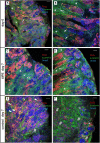An ex vivo Approach to Study Hormonal Control of Spermatogenesis in the Teleost Oreochromis niloticus
- PMID: 32793114
- PMCID: PMC7366826
- DOI: 10.3389/fendo.2020.00443
An ex vivo Approach to Study Hormonal Control of Spermatogenesis in the Teleost Oreochromis niloticus
Abstract
As the male reproductive organ, the main task of the testis is the production of fertile, haploid spermatozoa. This process, named spermatogenesis, starts with spermatogonial stem cells, which undergo a species-specific number of mitotic divisions until starting meiosis and further morphological maturation. The pituitary gonadotropins, luteinizing hormone, and follicle stimulating hormone, are indispensable for vertebrate spermatogenesis, but we are still far from fully understanding the complex regulatory networks involved in this process. Therefore, we developed an ex vivo testis cultivation system which allows evaluating the occurring changes in histology and gene expression. The experimental circulatory flow-through setup described in this work provides the possibility to study the function of the male tilapia gonads on a cellular and transcriptional level for at least 7 days. After 1 week of culture, tilapia testis slices kept their structure and all stages of spermatogenesis could be detected histologically. Without pituitary extract (tilPE) however, fibrotic structures appeared, whereas addition of tilPE preserved spermatogenic cysts and somatic interstitium completely. We could show that tilPE has a stimulatory effect on spermatogonia proliferation in our culture system. In the presence of tilPE or hCG, the gene expression of steroidogenesis related genes (cyp11b2 and stAR2) were notably increased. Other testicular genes like piwil1, amh, or dmrt1 were not expressed differentially in the presence or absence of gonadotropins or gonadotropin containing tilPE. We established a suitable system for studying tilapia spermatogenesis ex vivo with promise for future applications.
Keywords: Amh (anti-Müllerian hormone); FSH; LH; Nile tilapia (Oreochromis niloticus); hCG; pituitary extract; spermatogenesis; testis culture.
Copyright © 2020 Thönnes, Vogt, Steinborn, Hausken, Levavi-Sivan, Froschauer and Pfennig.
Figures




Similar articles
-
The role of StAR2 gene in testicular differentiation and spermatogenesis in Nile tilapia (Oreochromis niloticus).J Steroid Biochem Mol Biol. 2021 Nov;214:105974. doi: 10.1016/j.jsbmb.2021.105974. Epub 2021 Aug 20. J Steroid Biochem Mol Biol. 2021. PMID: 34425195
-
Blocking of progestin action disrupts spermatogenesis in Nile tilapia (Oreochromis niloticus).J Mol Endocrinol. 2014 Aug;53(1):57-70. doi: 10.1530/JME-13-0300. Epub 2014 May 14. J Mol Endocrinol. 2014. PMID: 24827000
-
Kisspeptin2 stimulates the HPG axis in immature Nile tilapia (Oreochromis niloticus).Comp Biochem Physiol B Biochem Mol Biol. 2016 Dec;202:31-38. doi: 10.1016/j.cbpb.2016.07.009. Epub 2016 Aug 3. Comp Biochem Physiol B Biochem Mol Biol. 2016. PMID: 27497664
-
Endocrine control of spermatogenesis in the ram.J Reprod Fertil Suppl. 1981;30:47-60. J Reprod Fertil Suppl. 1981. PMID: 6820054 Review.
-
Spermatogenesis in fish.Gen Comp Endocrinol. 2010 Feb 1;165(3):390-411. doi: 10.1016/j.ygcen.2009.02.013. Epub 2009 Apr 5. Gen Comp Endocrinol. 2010. PMID: 19348807 Review.
Cited by
-
Transcriptomes of testis and pituitary from male Nile tilapia (O. niloticus L.) in the context of social status.PLoS One. 2022 May 11;17(5):e0268140. doi: 10.1371/journal.pone.0268140. eCollection 2022. PLoS One. 2022. PMID: 35544481 Free PMC article.
-
Recent Progress of Induced Spermatogenesis In Vitro.Int J Mol Sci. 2024 Aug 5;25(15):8524. doi: 10.3390/ijms25158524. Int J Mol Sci. 2024. PMID: 39126092 Free PMC article. Review.
References
-
- Devlin RH, Nagahama Y. Sex determination and sex differentiation in fish: an overview of genetic, physiological, and environmental influences. Aquaculture. (2002) 208:191–364. 10.1016/S0044-8486(02)00057-1 - DOI
-
- França LR, Nóbrega RH, Morais RDVS, De Castro Assis LH, Schulz RW. Sertoli cell structure and function in anamniote vertebrates. Sertoli Cell Biol. (2015) 385–407. 10.1016/b978-0-12-417047-6.00013-2 - DOI
Publication types
MeSH terms
Substances
LinkOut - more resources
Full Text Sources
Research Materials

